#cafaggiolo
Explore tagged Tumblr posts
Text

Plate, by Maestro Jacopo (1510; Cafaggiolo, Italy) | source
#aesthetic#art#artblr#ceramic#ceramic art#ceramic artist#ceramic sculpture#ceramics#clay#design#handmade pottery#handmade ceramics#coterie#pottery#sculpture
14 notes
·
View notes
Text
Famiglia Alfani
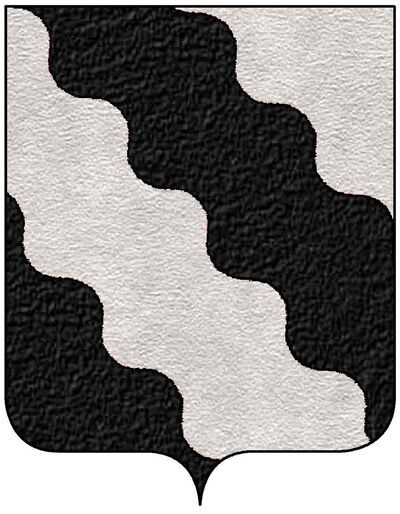
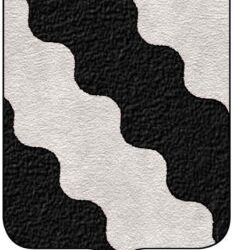
Gli Alfani debbono la loro fortuna alla loro attività di banchieri, nel periodo di tempo che va dal XII al XIV secolo, prestarono denari senza distinzione alcuna a papi e imperatori. Nel secolo XII ebbero dal Papa Eugenio III° l’incarico di riscuotere le decime dagli agricoltori e allevatori della Chiesa. Anche l’allora Vicario Imperiale in Toscana chiese al loro banco un prestito di 3400 fiorini d’oro, dando in garanzia i beni dell’Impero. Questa somma non venne mai restituita, gli Alfani rimasero proprietari dei terreni rivieraschi di San Miniato, Fucecchio e della Valle di Nievole. Durante il regno del Duca Alberto d’Austria, Vermiglio degli Alfani , fu nominato “familiare e tesoriere”, perché con l’aiuto finanziario ricevuto dal banco voleva riuscire a risollevare le sorti dell’Impero nella guerra di successione contro Adolfo di Nassau e essere incoronato re. Il Nassau era già stato da lui sconfitto nella battaglia di Gollheim, rimanendo ucciso nello scontro. Ma le speranze di essere intronato cessarono quando fu scelto Enrico VI°. Il banco di cambio aveva filiali in Ungheria, Polonia, Slovenia e Germania. ciò aumentava la potenza degli Alfani. L’Imperatore era molto in familiarità con Vermiglio tanto da chiamarlo “Vermilio fideli et creditori suo”. L’amicizia con il re tedesco insospettì il comune Guelfo di Firenze. Vermiglio venne obbligato a fare un prestito forzoso di 10000 fiorini, ma questi non tradì! La famiglia era Guelfa da molto tempo, la loro affiliazione alla fazione risaliva a dopo la battaglia di Montaperti, quando con l’avvento dei ghibellini vennero costretti ad andare in esilio. Dopo la morte dell’Imperatore, il banco continuò la sua attività, anche se non ebbe più incarichi pubblici in Firenze.
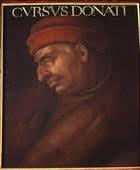
Nella famiglia Alfani ci furono sei Priori e due Gonfalonieri. In città curavano gli interessi di molti conventi toscani, tanto che Corso Donati, si rivolse al loro banco per contrasti con un monastero femminile. Al tempo della lotta fra le fazioni dei Bianchi di Vieri dè Cerchi e i Neri di Corso Donati, si schierarono con i primi. Quando i Neri nel 1302 risultarono vincitori, tutti gli appartenenti alla fazione dei Bianchi furono esclusi dalla politica cittadina. Vermiglio, come il poeta Dante Alighieri, dovette andare in esilio. A loro si unì il poeta stilnovista Gianni Alfani, autore della “Ballatella dolente”, dove descrive la nostalgia della Patria lasciata e il dolore di aver abbandonato la donna amata.

Nel 1315 Lapo degli Alfani, dopo la cacciata dei maggiori esponenti della famiglia dichiarati ribelli dall’Imperatore Enrico VII di Lussemburgo, vendette una casa agli Adimari in seguito questa abitazione venne venduta dagli stessi ai monaci Camaldolesi. Ancora nel 1347, Bartolomeo e Gianni Alfani, vendettero agli stessi monaci le rimanenti case ancora in loro possesso, i quali vi eressero il Monastero di Santa Maria degli Angeli. Negli anni seguenti, a onore di questa famiglia, è stata intitolata la strada dove si trova il monastero. In principio è stata chiamata via di Cafaggiolo, in seguito via dei Leoni, via del Ciliegio, via degli Agnoli, fino a prendersi l’attuale nome: degli Alfani. Le case della famiglia si trovavano nella località chiamata Cafaggiolo. Il cronista Giovanni Villani spiega che il nome deriva da “campo del faggio”, in affinità con il nome di Cafaggio con il quale era indicato il terreno per il pascolo, nome derivato dal latino medievale “Cafagium” di origine longobarda. L’ultimo discendente di Vermiglio Alfani, Pier Forese, si spense in Firenze nel 1694.
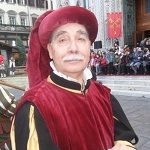
Alberto Chiarugi Read the full article
0 notes
Text

Alesso Baldovinetti (Florencia, 1425-1499)
Anunciación
alrededor de 1457
Témpera sobre tabla
Inventario 1890, no. 483
La tabla, que Vasari (1568) creía obra de Pesellino, fue pintada para la iglesia florentina de San Giorgio alla Costa anexa, en el momento de la ejecución del cuadro, al Monasterio de vallombrosano de Spirito Santo. Al igual que el Pali di Cafaggiolo, se distingue por el cuidado diseño y los colores claros imbuidos de luz derivados de las obras de Domenico Veneziano. En los Uffizi en 1868.
Información de la Gallerie degli Uffizi, imagen de mi autoría.
1 note
·
View note
Photo
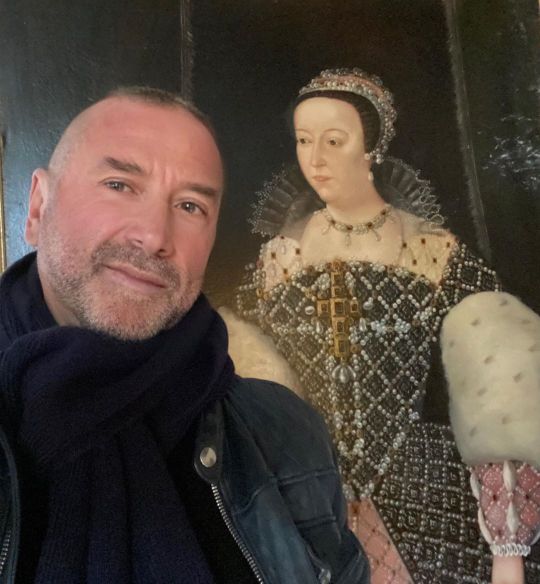
... a pochi chilometri da Firenze, immersa nel verde del Mugello “Cafaggiolo” meravigliosa residenza di campagna dei Medici... l’incontro tra Max e Caterina dè Medici (di Lorenzo dè Medici) è stato travolgente... cari amici francesi fatevene una ragione... questa controversa vostra sovrana (partita da Firenze nel 1547 e ferrea Regina di Francia fino al 1563) ha rivoluzionato la Vostra cucina toscanizzandola... poveri...!!! Neanche i “Macarons” avete inventato... ••• ••• ... a few kilometers from Florence, surrounded by the green of the Mugello "Cafaggiolo" wonderful country residence of the Medici ... the meeting between Max and Caterina dè Medici (by Lorenzo dè Medici) was overwhelming ... dear French friends make a reason ... this controversial sovereign of yours (left Florence in 1547 and iron Queen of France until 1563) has revolutionized your cuisine ... poor ... !!! Not even the "Macarons" have invented ... #buongiorno #goodmorning #history #cafaggiolo #tuscany #toscana #firenze #florence #france #queen #paris #reine #cooking #macarons #instagay #igers #proud #frenchfriend #soul #grindr #feelings #friend #friendship #nouvellecousine #beardedgay #time #caterinademedici #true (presso Villa medicea di Cafaggiolo) https://www.instagram.com/p/B8xX6T_o7Rv/?igshid=1k2jp12oliy8i
#buongiorno#goodmorning#history#cafaggiolo#tuscany#toscana#firenze#florence#france#queen#paris#reine#cooking#macarons#instagay#igers#proud#frenchfriend#soul#grindr#feelings#friend#friendship#nouvellecousine#beardedgay#time#caterinademedici#true
0 notes
Text
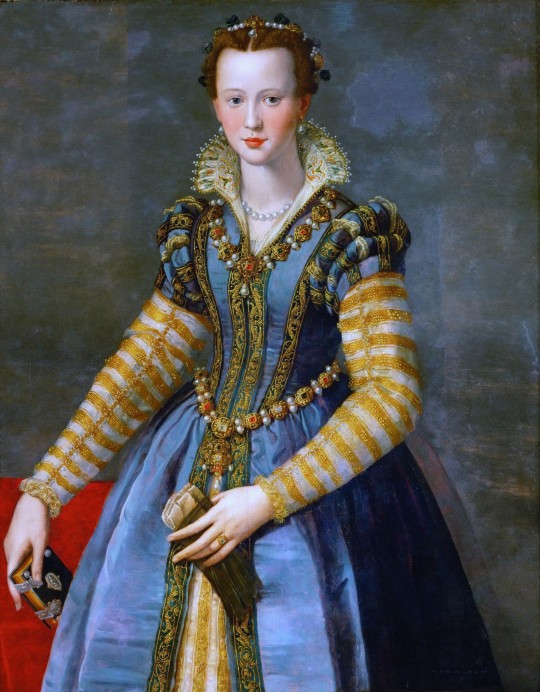
Alessandro Allori [a.k.a. Alessandro di Christofano di Lorenzo Allori; Il Bronzino; Alessandro del Bronzino; Alessandro Bronzino Allori (1535-1607), Eleonora ('Dianora') di Don Garzia di Toledo di Pietro de'Medici (1553 -1576), circa 1571.
"Leonora was born in Florence, where she was brought up by Cosimo I de' Medici, Grand Duke of Tuscany and his wife Eleanor of Toledo, her aunt and namesake. Betrothed to their son Pietro at the age of 15, she blossomed under the wing of Pietro's older sister, the artistic patron Isabella, into a vivacious and witty beauty. Her marriage, like Isabella's, was not a success, and she followed her mentor's example of taking lovers. For this reason, Pietro had her brought in 1576 to the country retreat of Cafaggiolo, where he strangled her to death with a dog leash. Cosimo's successor, Francesco I, tacitly approved the murder, and Pietro was never brought to justice for it." [source]
41 notes
·
View notes
Note
(not anon but) I have always been bothered by the way the show represented Giuliano, but the truth is that he and Lorenzo actually had a rather rocky relationship even when Piero was still alive. Lorenzo was groomed to be the Lord of Florence while Giuliano was rather left to his own devices without a clear path in life, which ultimately led him into long bouts of depression and anxiety through the 1470s 1/
(which may have caused the health problems that plagued him and kept him in bed on the proposed day of the conspiracy). Although he was of course portrayed as the “prince of youth” in works like Poliziano’s Stanze, he actually considered joining the church at one point for personal (ie. not political) reasons (Lorenzo then tried and failed to secure him a cardinal’s hat) 2/
He was rarely involved in politics and actually felt estranged from Lorenzo because his elder brother tried to keep him out of them. The relationship was not, in fact, a parallel of the Cosimo-Lorenzo or Piero-Giovanni relationship because of this (although Giovanni, like Giuliano, died rather early and wasn’t completely able to fulfill his role as co-ruler). 3/
Giuliano even approached Lorenzo multiple times to call attention to this as he sought a role in the government, but Lorenzo pushed him aside, an act that may actually have even directly led to the unfolding of the conspiracy. Notably, when Lorenzo proposed the law that would have prevented the Pazzi from accepting the Borromei inheritance, he said something along the lines of “if you focus so much on one trivial thing, you could make yourself lose everything” 4/
which is, in the end, exactly what happened. (Interestingly, Giuliano and Guglielmo dei Pazzi were apparently rather good friends). For anyone interested in sources, the most complete “biography” of Giuliano is in Le stirpe de Medici di Cafaggiolo (Perracini, 1924), and there’s a good bit about him and his involvement in politics in vol. 2 of the complete letters of Lorenzo (Giunti 1977). 5/5
ooh very interesting! i remember reading what giuliano said to lorenzo about the inheritance law and i’m still bummed out they didn’t include that plotline in the show bc a) the dramatic irony of it all and b) more concrete and reasonable motive for the pazzi. alas!!
edit: one more followup from @therepublicofletters!
I meant to say this in my ask but I forgot lol I'm getting my degree in Renaissance studies and the Medici/the Pazzi conspiracy is my main topic so if anyone ever needs historical stuff, you know where to find me
8 notes
·
View notes
Text
Ensayo sobre Medici: Masters of Florence.
Análisis de los tres primeros capítulos de la primera temporada.
Comenzamos viendo la arquitectura que compone la ciudad de Florencia, desde la iglesia de Santa María de Fiore, hasta elementos estructurales que ayudan al desenvolvimiento natural de los acontecimientos, como lo son el Palacio de Medici Ricardi y la Villa Cafaggiolo. Siendo un poco más específicos, la serie se abraza a la ciudad con la finalidad de que los espectadores se sientan sumidos en las escenas que se proyectan y la vida de cada personaje tenga sentido.

Santa María de Fiore es uno de los elementos que muestra una mayor jerarquía en la historia que se cuenta y de la misma se puede notar a simple vista que no ha sido terminada. Esta iglesia es un punto clave dentro de la historia del renacimiento, pues es durante este período que Cosme de Medici da la luz verde a Brunelleschi para comenzar a construir lo que en años siguientes se convertiría en la cúpula de Santa María de Fiore.

Es prudente decir que la arquitectura y los espacios no se apreciarían de la misma forma si la estética de los personajes y las cualidades de estos mismos no se adaptaran a la época. Esto logra apreciarse cuando estudiamos el trato que se tiene dentro de la familia Medici, el cual se adapta correctamente a los valores tan anticuados que se tenían en la época. Por ejemplo, al ser hijo de una familia tan adinerada, no podías contraer matrimonio con alguien que perteneciera a la plebe.

Hablando un poco más sobre los personajes, podríamos comenzar hablando del protagonista, Cosme di Medici. Si estudiamos su personalidad dentro de la serie podemos ver como su forma de pensar va siendo moldeada por sus padres, Giovanni Medici y Piccarda Bueri. Gracias a la manipulación de sus padres, Cosme decidió enfocarse de lleno en el campo de la banca y se divorcia completamente de sus sueños, a excepción de su deseo por culminar la Iglesia de Santa María de Fiore.

Para finalizar, se puede decir que esta serie es una buena forma de poder comprender, de una manera muy resumida y puntual, cómo surgió Florencia en el renacimiento y el papel que tomó la familia Medici en la historia de una ciudad que hoy en día es la llave principal que abrió paso a una nueva forma de ver la arquitectura.
#arquitectura#historia 2#arquitectura y urbanismo#historia de la arquitectura#renacimiento#arte#capitalismo#ciudad#feudalismo#Medici#mastersofflorence#Firenze
1 note
·
View note
Text
Caterina de' Medici ha un suo museo. A Cafaggiolo
Caterina de' Medici ha un suo museo. A #Cafaggiolo
A 500 anni dalla nascita di Caterina de’ Medici, avvenuta il 13 aprile 1519, Diana e Alfredo Lowenstein hanno annunciato che nella tenuta medicea di Cafaggiolo, a Barberino di Mugello, sarà realizzato il Museo di Caterina, secondo un progetto di massima predisposto da Cristina Acidini. Il museo si propone di presentare nella città metropolitana di Firenze, sua città natale, la personalità…
View On WordPress
0 notes
Text
Firenze è un groviera. E i topi ballano
Firenze è un groviera. E i topi ballano
Anna Lombroso per il Simplicissimus
Mentre intere regioni del paese crollano, si disintegrano, sprofondano, amministratori di città già provate si industriano in forma bipartisan per portarle a rovina certa nel rispetto della nuova interpretazione dell’Uguaglianza: tutti giù. Lo dimostrano due casi, le due più prestigiose e visitate città d’arte, Firenze e Venezia, sotto osservazione da parte…
View On WordPress
#aeroporto inceneritore#bene comune#Cafaggiolo#complesso Costa San Giorgio#Firenze#Mugello#Nardella#patrimonio culturale#Renzi#svendita#Tav#Unesco#valorizzazione#Venezia
0 notes
Note
Intanto fai post pro fake Novella ma poi critichi solo Clarice e Lore con falsità tipo che lei muore e lui se ne frega, o che mentre lei era via lui pensava alla Donati quando non c'era nessuna relazione. Se lui non visitava moglie e figli a volte non è xché si stava divertendo, c'erano peste e attentati infatti Clarice nelle lettere è preoccupata che lui non dica la verità. Lei aveva influenza eccome: molti andavano da lei per chiedere favori al marito. Leggi lettera "per amore di clarice"
“Intanto fai post pro fake Novella ma poi critichi solo Clarice e Lore con falsità tipo che lei muore e lui se ne frega“
Innanzitutto ti prego di leggere , come ti ho già scritto, altri miei post sui Medici tipo QUESTO. Di nuovo, ho criticato TUTTE le storie d’amore della serie tv, da questa a quella di Giuliano e Simonetta. Quindi, ti pregherei prima di accusarmi, di leggere.
Inoltre, ho scritto e riscritto che Lorenzo provava affetto per Clarice, la rispettava e le voleva bene. non capisco davvero di cosa tu ti stia lamentando. Quello che poi io ho aggiunto, è che la realtà della loro storia, era meno romanzata di cosi:
Lorenzo abitava a Firenze e Clarice a Carafaggiolo? Si.
Lorenzo componeva sonetti PURAMENTE PLATONICI per Lucrezia? Si
Clarice aspettava Lorenzo per cena e lui non si presentava? Si.
“Avrei tanto caro fussi venuto a goderle qui con essi noi, che v’abbiamo aspettato già son tre sere infino alle tre ore”. ( Clarice a Lorenzo)
per inciso, sperando di chiudere la questione, qui c’è un pensiero riassunto di come penso sia stata la relazione tra i due.
Nella dimora di via Larga – opificio del pensiero neoplatonico, cantiere delle arti – Clarice vive poco. Nei vent’anni passati accanto al marito, la Orsini si trova quasi confinata con i figli nella villa di Cafaggiolo, dove Lorenzo – non amando la caccia – si fa vedere di rado. E tuttavia lei lo aspetta.
Estratto
per essere ancora più precisi, Wikipedia scrive:
Clarice aveva un carattere religioso che mal si adattava alla mentalità aperta degli umanisti, dei quali suo marito era il perno. La musa ispiratrice di Lorenzo era stata infatti la fiorentina Lucrezia Donati, alla quale dedicò le sue poesie, mentre non ne dedicò alcuna alla consorte. Tuttavia, se si considera il contesto del tempo, non stupisce che la Orsini non fosse oggetto di quel tipo di attenzione: la lirica di Lorenzo seguiva la scuola trobadorica e le teorie di Andrea Cappellano secondo cui l'Amor Cortese può essere soltanto adulterino, escludendo quindi un rapporto matrimoniale. Secondo la mentalità di quel tempo, dedicare quel tipo di poesia alla propria moglie, quindi la compagna ufficiale e legittima, poteva essere visto come inconsueto e perfino di poco gusto. Nonostante le differenze fra loro ed il fatto che il matrimonio fu combinato, la corrispondenza fra i due mostrava toni di affetto e rispetto reciproco. A differenza di suo padre e suo nonno, Lorenzo non ebbe figli illegittimi ed ebbe la numerosa prole solo da Clarice. [2]
Per poi continuare:
il marito espresse tutto il suo dolore e difficoltà nell'accettare la perdita della consorte...
Quindi, come puoi vedere, mentre come sostengo da sempre Lorenzo provasse stima, affetto, rispetto, e gratitudine verso questa donna, la serie tv ha romanzato questa relazione.
6 notes
·
View notes
Photo

Eleonora di Garzia di Toledo (1553 – 1576)
Known as "Leonora" or "Dianora", she was daughter of García Álvarez de Toledo, Marquis of Villafranca and Duke of Fernandina, and Vittoria Colonna, the niece of the poet. Leonora was born in Florence and when her mother died, she was left in the care of her aunt Eleonora di Toledo, the Duchess of Florence. Eleonora and Cosimo raised her lovingly at the Medici court, where she remained for the rest of her life. The red-headed Leonora, who possessed a natural charm, was popular in the Medici family. At the age of five, she was reported as being a comfort to Cosimo's second daughter Lucrezia, from whom she became inseparable, when Lucrezia was apart from her husband Alfonso d'Este. The Duke Cosimo was extremely fond of Leonora, and treated her as his own daughter. He was charmed by her vivacity and physical vigour — she delighted in horsemanship and arms — though he occasionally gently reminded her to behave with more decorum.
Owing to the close family and political ties between the House of Medici and the viceroyal family of Toledo, a marriage was arranged between Leonora and Cosimo's son Pietro, with whom she had grown up and who was of a similar age. The couple were betrothed when she was 15, with the approval of Philip II of Spain. Garcia Álvarez de Toledo provided her with a dowry of 40,000 gold ducats. They were married at the Palazzo Vecchio in April 1571, and it was reported that Pietro had to be forced to consummate the union. Pietro nevertheless had affairs with other women, and the reasons for his aversion to sexual intercourse with Leonora are unknown. In 1573, Leonora gave birth to a son, Cosimo, who was the sole male Medici heir in this generation until his death three years later, one month after his mother's death.

This marriage was never a physical and emotional success. In this it resembled that of Isabella de Medici, whose protégée Leonora became, and Paolo Giordano Orsini. Although Isabella had two children by Paolo Giordano, she had chosen not to live at her husband's castle at Bracciano or in Rome, where he conducted his political and amorous affairs. Instead, with Cosimo's permission, she had remained in Florence, cultivating an artistic salon at her Villa Baroncelli in the south of the city, and discreetly taking lovers, notably Troilo Orsini, a cousin of her husband's.
Leonora became part of Isabella's circle and renowned for her beauty and vivacity. Leonora saw Isabella as her role model and engaged in the same kind of intellectual activities, music and sports. Like Isabella, she sponsored charities and the arts, serving as the patron of the literary Accademia degli Alterati. Neglected by her husband, she also followed Isabella's example in taking lovers. Under Cosimo, such behaviour was tolerated as long as discretion was maintained and the marriages reaped political advantages. The women's respective husbands conducted affairs of their own, leading largely separate lives. Thus matters stood until the death of Cosimo. His successor, the reclusive Grand Duke Francesco, was, however, very different. He was less willing to turn a blind eye to the behaviour of Isabella and Leonora and to the complaints of their spouses, for whom their adultery was a question of honour rather than jealousy.

On 11 July 1576, Pietro de Medici sent a note to his brother, Grand Duke Francesco, from the Villa Medici at Cafaggiolo, north of Florence: "Last night at six hours an accident occurred to my wife and she died. Therefore Your Highness be at peace and write me what I should do, and if I should come back or not." The next day, Francesco wrote to his brother Ferdinando in Rome: "Last night, around five o'clock, a really terrible accident happened to Donna Leonora. She was found in bed, suffocated, and Don Pietro and the others were not in time to revive he.”
In fact, Leonora's death was not an accident: Pietro had murdered her in cold blood, with Francesco's connivance. She was 23. Six days later, in a similar manner, her best friend, Isabella de Medici, was strangled by her husband, Paolo Giordano. Francesco announced the death of his sister as an accident. Bastiano Arditi recorded that Leonora was "deposited in a box, in San Lorenzo, without any other ceremonies". The diarist Agostino Lapini recorded that everyone knew very well that Leonora had been killed. At first, Grand Duke Francesco put it about that Leonora had died of a heart attack. But the Florence grapevine knew otherwise, and the Spaniards were outraged at this treatment of such a high-ranking subject of their crown. Under pressure, Francesco eventually admitted the truth. He wrote to Philip II of Spain, on whose favour his title depended:
"Although in the letter I had told you of Donna Eleonora's accident, I have nevertheless to say to His Catholic Majesty that Lord Pietro our brother had taken her life himself because of the treason she had committed through behaviour unbecoming to a lady ... We wish that His Majesty should know the truth ... and at the first opportunity he will be sent the proceedings through which she should have known with what just reasons Lord Pietro acted".

The "proceedings" Francesco had in mind concerned the documented behaviour of Leonora's lover Bernardino Antinori, who had often been seen publicly with her in her coach. Francesco had imprisoned Antinori, and he was strangled in his cell two days before Leonora met the same fate. Love letters and poems written by Antinori, extolling Leonora's beauty and charms in minute Petrarchian detail, were "found hidden in her foot stool". There was also a political dimension to the murders, because Antinori and another associate of Leonora's, Pierino Ridolfi —according at least to Ridolfi's confession under torture— were implicated in an anti-Medici vendetta led by Orazio Pucci. For this reason, Francesco convinced himself that Leonora's misdemeanours had also encompassed treason.
In 1575, Cortile reported to the Duke of Ferrara: "Pierino Ridolfi has been accused of plotting to kill Don Pietro while he was in a whorehouse, to murder his son and poison Cardinal Ferdinando. He is in the service of Donna Leonora and the duke is in a great rage with her for having given Pierino a necklace worth 200 scudi and a horse on which to escape". Francesco, reported Cortile, was "prepared to wash his hands of his sister-in-law". Caroline P. Murphy regards these charges against Leonora as excessive, particularly the notion that she would plot the death of her own son. Francesco's approval meant that Pietro was never brought to justice for Leonora's murder, despite the protests of her brother Pedro Álvarez de Toledo y Colonna that her death was unacceptable. (X)
21 notes
·
View notes
Text

Alesso Baldovinetti (Florencia, 1425-1499)
La Virgen y el Niño con los Santos Francisco, Cosme, Amiano, Juan Bautista, Lorenzo, Giuliano, Antonio Abate, Pietro Martire.
"Retablo de Cafaggiolo"
alrededor de 1453
Témpera sobre tabla
Inventario 1890, no. 487
El panel, anteriormente en el altar de la capilla de la villa Medici de Cafaggiolo en Mugello, renovado en 1451 por Michelozzo, probablemente fue encargado en 1453 por Piero il Gottoso para el nacimiento de su hijo Giuliano (1453-1478), hermano de Lorenzo el Magnífico, al que alude el santo epónimo. Es una de las raras pinturas del artista, que también fue un apreciado mosaicista. En los Uffizi en 1796.
Información de la Gallerie degli Uffizi, imagen de mi autoría.
1 note
·
View note
Video
(via mostra cafaggiolo | www.daovi.net | Dasha Vigori Oussova | Flickr)
2 notes
·
View notes
Text
Villa Cafaggiolo nel territorio mediceo del Mugello
Villa Cafaggiolo nel territorio mediceo del Mugello
Villa Cafaggiolo da vecchio maniero a villa residenziale medicea
Villa Cafaggiolo nel suo insieme con alle spalle il bosco e sulla sinistra Borgo Cafaggiolo
Il territorio del Mugello, durante la grande signoria dei Medici, era terra di acquisizione, ne facevano incetta soprattutto dei terreni attorno a manieri, case e palazzi signorili e “casotti” di campagna.
Questo è il caso di Vil…
View On WordPress
0 notes
Text
Matteo Renzi (Italia Viva) a Cafaggiolo per le Regionali 2020
0 notes
Text
Art Patrons: The Medicis
If it weren’t for the Medici family, some of our favorite Renaissance artists would have died of starvation and even worse, in obscurity. Some of them did, but the Medicis saved as many of them as they could. They didn’t want to be heroes, they wanted to be rulers. The Medici family were the real OGs and their back story is sure to convince anyone.
The family moved to Florence sometime in the 12th century. They must’ve grown tired of the village life in Cafaggiolo. The big fish in the small pond eventually gets bored of the small pond. Now, I have no idea if the Medicis were the big fish of Cafaggiolo, but they grew a fair amount after the big move. Within the century, in 1397, Giovanni Medici had established the most popular bank in Florence. I guess big fish can make it rain.
Cosimo or Cosimo the Elder was Giovanni’s son. He initiated the unofficial rule of Florence and crowned himself king. His kid, Piero could care less about banking. He just wanted to be a ruler. Unfortunately, there were way too many people who’d do anything to stop that from happening. Piero walked a fine line and managed to die of natural causes. His son, Guiliano, wasn’t that lucky.
Lorenzo and Guiliano patronized the arts, just like their father, when they started ruling Florence together. Lorenzo made artists like Botticelli, Michelangelo, and Leonardo da Vinci. Guiliano was as invested in the arts as his brother. But, he had to stop in 1478 when he got stabbed at church. Drama! Da Vinci was around when Lorenzo found the last of the conspirators and had them hung at the Bargello. The Italian artist couldn’t have asked for a better reality show, Murder with the Medicis.
Tomb of Giuliano de’ Medici by Michelangelo, in the Pushkin State Museum of Fine Arts, Moscow
Lorenzo named his son Piero. Turns out the Medici family is just a succession of Giovannis, Lorenzos, Cosimos, and Pieros. It gets confusing, often. Within a century, there are at least two Medicis with the same name. This Piero almost cost the family everything. In 1494, the Medicis were forced to flee Florence, their bank crashed, the people of Florence wanted their heads. Sh*t got real for the fam.
In 1512, they were allowed to return to Florence. But, they no longer had any sons to take the reins. It was time for Giovanni’s brother’s kids to have a go. Enter Cosimo de Medici.
Perseus with the head of Medusa by Benevenuto Cellini, in Loggia dei Lanzi, Florence
Florence should’ve been warned, but Cosimo didn’t want to take any chances. He got Cellini to build him an 17-ft sculpture of Perseus with Medusa’s head. It was designed to be a message to the people, “You denounce the Medici name again, and I will have your head”. Cosimo wasn’t joking around.
The Presentation of Marie de' Medici's Portrait to Henry IV by Peter Paul Rubens, in the Louvre, Paris
The Medici would now have crowns and titles. His kids and their kids would marry into influential families in France and England. Rubens painted the celestial introduction of Marie Medici, Cosimo I’s granddaughter, to Henry IV. It’s quite exquisite, isn’t it? When cherubs tell you this woman is the one, she has got to be the one. Especially, if it’s the woman that has commissioned Peter Paul Rubens, no less, to make the marriage look better than it was. Hmmm. I wonder who taught her that.
The family plowed through the rough times. Always getting back up on their feet. However, their resilience would soon wane. The Medicis were out of men and the dynasty was going to crumble any day. The last Grand Duke of Tuscany died in 1737, without a son. That was the end of the family. Florence was up for grabs again.
By: Ba!
#art history#history of art#art historian#art collectors#art collections#italian renaissance#art history 101#the medicis#medici family#art patrons#serious art history
0 notes